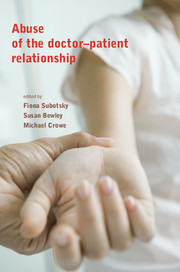Book contents
- Frontmatter
- Contents
- List of figures, tables and boxes
- List of contributors
- Foreword
- Introduction: mapping the territory
- 1 The ethical importance of boundaries to intimacy
- 2 The patient's perspective: impact and treatment
- 3 Teaching ethics and ethical behaviour to medical students
- 4 With the benefit of hindsight: lessons from history
- 5 The prevalence of boundary violations between mental health professionals and their clients
- 6 Psychiatry: responding to the Kerr/Haslam Inquiry
- 7 The general practitioner and abuse in primary care
- 8 Boundaries and boundary violations in psychotherapy
- 9 Sexual therapies: ethical guidelines, vulnerabilities and boundaries
- 10 Obstetrics and gynaecology: a special case?
- 11 Nurses as abusers: a career perspective
- 12 Medical management: governance and sexual boundary issues
- 13 Dealing with offending doctors: sanctions and remediation
- 14 Defending doctors: the protection society's experience
- 15 Regulation and its capacity to minimise abuse by professionals
- 16 The role of the General Medical Council
- Appendix 1 Extract from Vulnerable Patients, Safe Doctors
- Appendix 2 Codes of ethics of psychiatric associations in other countries
- Appendix 3 Guidance from the Council for Healthcare Regulatory Excellence
- Appendix 4 Examples of determinations by the General Medical Council's Fitness to Practise panels
- Appendix 5 Website resources and information
- Index
- Plate section
12 - Medical management: governance and sexual boundary issues
Published online by Cambridge University Press: 02 January 2018
- Frontmatter
- Contents
- List of figures, tables and boxes
- List of contributors
- Foreword
- Introduction: mapping the territory
- 1 The ethical importance of boundaries to intimacy
- 2 The patient's perspective: impact and treatment
- 3 Teaching ethics and ethical behaviour to medical students
- 4 With the benefit of hindsight: lessons from history
- 5 The prevalence of boundary violations between mental health professionals and their clients
- 6 Psychiatry: responding to the Kerr/Haslam Inquiry
- 7 The general practitioner and abuse in primary care
- 8 Boundaries and boundary violations in psychotherapy
- 9 Sexual therapies: ethical guidelines, vulnerabilities and boundaries
- 10 Obstetrics and gynaecology: a special case?
- 11 Nurses as abusers: a career perspective
- 12 Medical management: governance and sexual boundary issues
- 13 Dealing with offending doctors: sanctions and remediation
- 14 Defending doctors: the protection society's experience
- 15 Regulation and its capacity to minimise abuse by professionals
- 16 The role of the General Medical Council
- Appendix 1 Extract from Vulnerable Patients, Safe Doctors
- Appendix 2 Codes of ethics of psychiatric associations in other countries
- Appendix 3 Guidance from the Council for Healthcare Regulatory Excellence
- Appendix 4 Examples of determinations by the General Medical Council's Fitness to Practise panels
- Appendix 5 Website resources and information
- Index
- Plate section
Summary
Principles
Trusts are responsible for their patients’ and staff's welfare and safety, and cannot assume that everyone knows or is committed to the idea that sexual or other harassment of patients or staff is unacceptable. The first step therefore is to make this clear. The importance of being proactive, apart from the intrinsic morality and duty to prevent harm, is that sexual harassment of a variety of kinds is common, and can go on for years without being acted against. It is not enough to rely upon ‘professional codes’ and their regulatory enforcement, although these may help. Recent guidance from the General Medical Council (GMC) on this topic – Maintaining Boundaries (2006) – is strongly recommended, as are the recommendations of the Council for Healthcare Regulatory Excellence (2008).
Sexual harassment and abuse of patients by doctors can fall into any, or all, of the following categories of transgression:
• against trust disciplinary codes and policies
• against guidelines produced by the relevant Royal College
• against GMC guidelines
• against the law.
All have their own methods of investigation and sanctions, which unfortunately may be at cross-purposes with each other, and so clear liaison links and responsibility are vital. While College and GMC guidelines have been revised, and the legal situation changed with the Sexual Offences Act 2003 (Home Office, 2004), the employer has a primary responsibility for setting clear standards and ensuring enforcement. Trust policies should apply to all staff, not just clinicians, and be explicit about what sorts of behaviour are acceptable and which are not acceptable. They should include what sorts of ‘touch’ are allowable, whether exceptions about sexual relationships are permissible with ‘former patients’ and, if so, how this could be defined. If there has been a pre-existing, or there is a current, such relationship with a patient or carer, it should be the responsibility of the member of staff to discuss this with a manager. Other boundary issues, such as socialising or financial transactions, also need discussion, as they can be part of a ‘slippery slope’. In addition, supportive ‘whistle-blowing’ policies are essential so that staff, regardless of their status, can safely report concerns about other staff's behaviour.
- Type
- Chapter
- Information
- Abuse of the Doctor-Patient Relationship , pp. 138 - 150Publisher: Royal College of PsychiatristsPrint publication year: 2010

